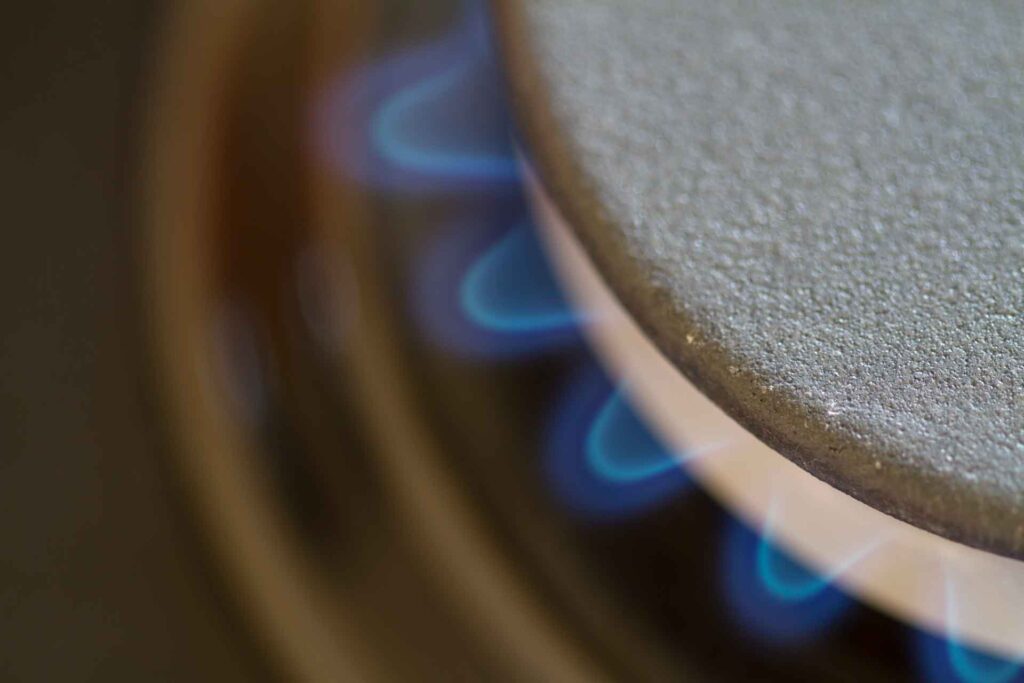It’s not always easy to know the differences between crude oil, natural gas, diesel, and gas oils. Yes–they all come from underground (at least nowadays), but they have different chemical properties, making the whole topic much more confusing.
You also have some products with additives added to them, pushing up the matter’s complexity even more.
This post is helpful if you’re scratching your head on this topic. It overviews diesel, natural gas, crude oil, and the rest. As you will discover, there is some crossover between them, but they are distinct in other ways.
Crude Oil
Crude oil is a natural substance (despite the impression you might get when reading about it in articles online). It took millions of years to form in the ground through the accumulation of algae on the seafloor in a sedimentation process.
Over geological time, this sediment got caught under silt and layers of rocks, leading to increased pressure and heating, changing the chemical composition. Eventually, this process led to the formation of various hydrocarbons, which civilization uses today as fuels.
Because of this, many people refer to crude oil as “full-spectrum” because it possesses all types of fossil fuel products that arise in liquid form. Various molecules in the substance, including naphthenes, have long chains of carbon atoms, while others have shorter chains, called paraffins, for light applications.
Crude oil isn’t refined (which is something that many people new to the industry imagine). Instead, it is more like a soup with other chemical constituents. Refiners must remove these to extract the juicy hydrocarbons they want to power modern industrial civilization.
However, these additional substances aren’t automatically a net negative. Oxygen, sulfur, benzene, and nitrogen are helpful in various industrial processes, making them valuable.
“Crude oil isn’t refined.“
Going back through time, you can find crude oil referred to as “sweet,” “light”, “sour,” and “heavy.” These terms crop up all over the place, especially in industry articles.
Sweet refers to the sulfur content of the crude. The “sweeter” it is, the less sulfur it contains. To get a crude classified as officially sweet, it needs less than 0.5% sweet by volume. People started using this moniker literally because of how the gas smelled. Sweet crude had a better aroma for busy workers’ nostrils (simply because of the foul-smelling nature of high-sulfur oil, called “sour.”)
Light crude oils, by contrast, are those that are more straightforward to refine. These contain less of the heaviest hydrocarbons which are so problematic (and tend to settle more on the bottom of fractionating towers).
Natural Gas
The other significant difference between gas and oil is that the former is mostly methane (one carbon and four hydrogen atoms). In contrast, the latter contains many heavier hydrocarbon elements that emerge from the ground in liquid form.
Most natural gas remains gaseous after extraction. The heavier gases propane and butane will separate from the material and form liquids once brought to the surface. (High underground temperatures keep them in gas form).
Like crude oil, natural gas contains nonhydrocarbon elements. These combine with the gas in the rock and underground cavities, forming a chemical soup that must be processed. Common ancillary chemicals include carbon dioxide, hydrogen, nitrogen, and noble gases, such as helium and argon. These can diminish natural gas’s ability to combust efficiently. That is, processors must remove them before sending gas through pipes to people and businesses.
Until recently, producers considered natural gas an undesirable by-product of oil production. Oil companies would drill wells and flare off the produced gas to get rid of it at the lowest cost.
During the two oil price shocks in the 1970s, the industry began to change its tune, realizing how it could put the intrinsic energy value of natural gas to work in various applications, including liquid fuels.
Burning gas was prevalent because it produced little soot compared with coal. In addition, it reduced the amount of methane, a potent greenhouse gas, in the atmosphere. It was also becoming more economical.
During the middle of the twentieth century, engineers began to perfect pipeline engineering, allowing low-cost transportation of the substance.
Diesel
This fraction of crude oil is mainly used in internal combustion engines and generators. Compared to petroleum, diesel is heavier due to the size of the carbon atoms that compose its molecules. Owing to this fact, it boils at a higher temperature. Sometimes some people refer to it as “heavy oil,” but as a name, it is less common than it was.
The most common type of diesel is petroleum diesel. It contains between 9 and 25 carbon atoms in every molecule.
“Biodiesel is the same chemical derived from recent organic matters such as animal fat or vegetable oil. “
Diesel fuel is obtained from crude oil by fractional distillation between 200 and 350 °C (392 and 662 °F) at atmospheric pressure.
However, only some crudes yield this product to meet the commercial and industrial requirements. Therefore, some refineries do “cracking,” which involves breaking up less valuable heavier hydrocarbons into lighter, more useful ones.
Other additives, such as kerosene jet fuel, can be mixed in, which gives better viscosity. Biodiesel is the same chemical derived from recent organic matters such as animal fat or vegetable oil.
Several processes and catalysts isomerize these ester compounds, elongating the chains to become more like hydrocarbons, leaving water and glycerine by-products.
U.S. regulations dictate that suppliers store diesel fuel in yellow containers. By this way, it is feasible to differentiate the fuel from kerosene, stored in blue, and gasoline, in red. In the UK, refiners and distributors store diesel fuel in black containers.
Gas Oils
Gas oil is a type of diesel. Therefore, diesel oil and gas oil do not differ so much in their constituent composition.
The main difference in their application is that diesel is used in vehicles, whereas gas oils are used for non-vehicle applications.
This might find practical applications in the usage by heavy-duty off-road vehicles, including mining trucks and mobile drills; the different operations require highly energy-dense fuels to operate them. Other consumers of gas oil include generators and other industrial machinery.
Changes in regulations thus coined the term “gas oils” in many locations; many governments sought to tax fuel used in vehicles yet did not want to add heavy charges to fuel oils used to heat homes and run generators.
With this approach, authorities in places like the UK developed two gas oil types: red and white.
The former had dye added to it and was permitted only for use in non-private-vehicle applications, while the latter was available to the average motorist at forecourts. This meant the government could tax one version of the fuel at the forecourts while not having any on the other.
Comparing Crude Oil, Natural Gas, Diesel, And Gas Oils
So, let’s get down to it: what are the differences between these compounds and substances?
Table of the differences between crude oil, natural gas, diesel, and gas oils
| Crude oil | Natural Gas | Diesel | Gas Oils | |
| How does it look? | Natural substances with a full spectrum of hydrocarbons of varying lengths and weights | Hydrocarbon molecules that are gaseous at regular pressures and temperatures | Heavier hydrocarbons with between 9 and 26 carbon atoms in their central chains | Heavier hydrocarbons and more viscous than conventional petroleum and (sometimes) diesel |
| What’s it for? | None before refining | Heating, cooking, water heating, air conditioning, electricity generation | Standby generators in hospitals, trucks, and vans, farm equipment, oil heaters | Fuel for off-road vehicles, heavy equipment, machinery, rail transport, farm equipment, etc. |
| Where does it come from? | Natural bedrock, including limestone and shale | Natural bedrock, including shale and sedimentary formations | Distillate of crude oil, heavier fraction | Distillate of crude oil, heavier fraction |
| What temperature does it boil? | Massive variation depending on fractions present (from 40°C to 500°C+) | At least -161°C for conventional LNG | Between 150°C and 350°C | 200°C to 380°C |
| What are the environmental problems? | Can result in natural gas flaring (releasing CO2), and spillages | Can produce methane leaks that worsen global warming (more than CO2) | Releases dangerous nitrous oxide particulate matter when burnt | Emits CO2 and additional pollutants, even when burned efficiently |
| What processing does it require? | Requires considerable refining, including fractionation and standardization | Requires purification to remove unwanted compounds, like sulfur | Required to perform to emissions standards in many Western countries | Requires special processing to meet application-specific requirements |
You can see the most significant differences between oil and natural gas because one is a liquid at sea level temperatures and pressures, while the other isn’t. Diesel and gas oils are more similar, with the main difference being the words people choose to use: diesel for vehicles, and gas oils for most other applications.
Conclusion
So, what have we learned from all this? Ultimately, we’ve seen that studying the difference between crude oil, natural gas, diesel, and gas oils isn’t straightforward. Some are natural raw materials (natural gas and crude), while others are refined products. The former aren’t usable by themselves by our industrial civilization, but the latter are.











